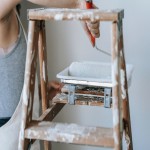Introduction:
Achieving a flawless interior paint job in your Toronto home requires more than just choosing the right colors and applying the paint. Proper preparation is essential to ensure a smooth, long-lasting finish. In this blog post, we will provide expert tips and guidance on interior painting preparation in Toronto. From surface preparation and repairs to priming and protecting your space, we will cover the essential steps that will set the foundation for a successful paint job.
1. Clearing and Protecting the Space:
Before you begin any interior painting project, it's crucial to clear the space and protect your furniture, flooring, and fixtures. Remove furniture from the room or move it to the center and cover it with plastic sheets or drop cloths. Use painter's tape to protect baseboards, trim, and any other areas that you want to keep paint-free. Cover the floors with drop cloths to prevent accidental spills and splatters. By taking these precautions, you can protect your belongings and ensure a cleaner and more efficient painting process.
2. Cleaning and Preparing Surfaces:
Proper surface preparation is the key to a smooth and professional paint finish. Begin by thoroughly cleaning the surfaces to remove any dirt, dust, grease, or stains. Use a mild detergent and warm water solution to clean walls, ceilings, and other painted surfaces. For stubborn stains or grease, you may need to use a stronger cleaner or degreaser. After cleaning, allow the surfaces to dry completely before moving to the next step.
3. Repairing Imperfections:
Inspect the surfaces for any imperfections, such as cracks, holes, or dents. Fill these imperfections with a high-quality spackling compound or wood filler, depending on the material of the surface. Use a putty knife to apply the filler smoothly and level it with the surrounding surface. Once the filler is dry, sand it lightly to create a smooth and even surface. This step is crucial for achieving a flawless paint finish and ensuring that the imperfections are not visible after painting.
4. Sanding and Smoothing:
Sanding the surfaces is an essential step to create a smooth and paint-ready surface. Use fine-grit sandpaper or a sanding block to gently sand the walls, ceilings, and other painted surfaces. This helps to remove any uneven texture, rough spots, or glossy finishes, allowing the paint to adhere properly. Sanding also helps in creating a better bond between the old and new layers of paint. After sanding, be sure to clean the surfaces again to remove any dust or debris.
5. Priming for Better Adhesion:
Priming the surfaces before painting is highly recommended, especially when dealing with new drywall, patched areas, or surfaces with varying porosity. A high-quality primer creates a smooth and uniform surface, promotes better adhesion of the paint, and improves color accuracy. Apply the primer evenly using a brush or roller, following the manufacturer's instructions. Allow the primer to dry completely before applying the paint.
6. Choosing the Right Paint and Tools:
Selecting the right paint and tools is crucial for a successful interior painting project. Choose a high-quality paint that is suitable for the specific surface you are painting, whether it's walls, ceilings, or trims. Consider factors such as sheen level, durability, and washability based on the needs of each room. Invest in good-quality brushes, rollers, and other painting tools to ensure a smooth and even application.
7. Proper Ventilation:
During the painting process, it's essential to maintain proper ventilation in the room. Open windows and doors, or use fans to circulate fresh air. Proper ventilation helps in drying the paint faster and reduces the odor from the paint fumes
. Additionally, it creates a more comfortable working environment for you.
8. Applying Paint with Care:
When it's time to apply the paint, use a consistent and even technique. Start with cutting in the edges using a brush, and then use a roller for larger areas. Apply the paint in thin and even coats, allowing each coat to dry before applying the next. This ensures a smooth and professional finish without visible brush strokes or roller marks. Be sure to follow the paint manufacturer's instructions regarding drying times and recoat intervals.
Conclusion:
Proper preparation is the foundation for a flawless interior paint job in your Toronto home. By following these expert tips for surface preparation, repairs, priming, and paint application, you can achieve a smooth and long-lasting finish that enhances the beauty of your space. Take the time to prepare your surfaces carefully, use high-quality materials, and pay attention to details. With proper preparation, your interior paint job will not only look professionally done but also stand the test of time.










